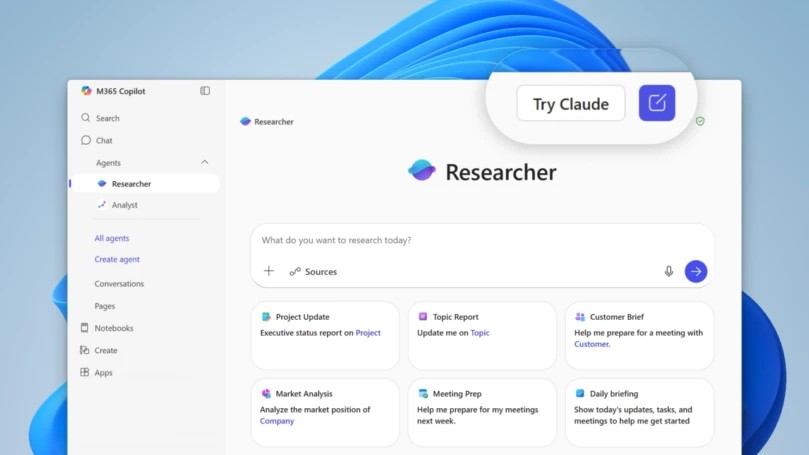Microsoft Broadens AI Strategy with Anthropic Integration in Microsoft 365 Copilot
In a significant shift in its artificial intelligence strategy, Microsoft has announced that Anthropic’s Claude models will now be available as an option within Microsoft 365 Copilot, the company’s AI-powered productivity assistant for business users. This expansion represents a notable evolution from Microsoft’s previous approach, which relied primarily on OpenAI’s GPT models and its own proprietary AI technology. The integration begins with the Researcher agent in Microsoft 365 Copilot, which can now utilize Anthropic’s Claude Opus 4.1 alongside OpenAI’s models, giving users flexibility in choosing their preferred AI foundation. Microsoft CEO Satya Nadella described this multi-model approach as “bringing the best AI from across the industry to Copilot, tuned for work and tailored to every business,” signaling the company’s commitment to offering diverse AI options that meet various business needs rather than limiting customers to a single AI provider.
This strategic expansion comes amid evolving dynamics in the AI landscape, particularly in Microsoft’s relationship with OpenAI. The announcement arrives shortly after OpenAI secured a potential $100 billion investment from Nvidia—a development that Microsoft reportedly supported despite being OpenAI’s largest investor to date. Some industry observers had speculated about tension between the companies following reports that Microsoft was only informed about the Nvidia deal shortly before its signing. However, sources familiar with the situation indicate Microsoft was neither surprised by nor opposed to the investment, suggesting a more complex and potentially collaborative relationship between these major AI players than previously understood. The timing of Microsoft’s Anthropic integration raises questions about whether the company is deliberately diversifying its AI partnerships to reduce dependence on any single technology provider.
Microsoft 365 Copilot, the company’s enterprise-focused AI assistant, differs significantly from the consumer-oriented Copilot available in Windows or Bing. Designed specifically for workplace productivity, it integrates deeply with business applications like Word, Excel, Outlook, and Teams, offering enhanced capabilities for professional users. The addition of Claude models expands beyond just the Researcher agent—Anthropic’s technology will also be available in Copilot Studio, Microsoft’s platform for creating and managing custom AI agents. This broader integration suggests Microsoft is committed to offering business customers flexibility and choice in how they implement AI tools across their organizations, recognizing that different AI models may excel at different types of tasks or align better with specific business requirements.
This isn’t Microsoft’s first partnership with Anthropic or other AI developers outside its OpenAI relationship. Earlier this year, the company announced that Anthropic’s Claude Code would be available as part of GitHub Copilot, Microsoft’s autonomous coding assistant, alongside OpenAI’s Codex. The company has also revealed plans to offer Elon Musk’s xAI models—Grok 3 and Grok 3 Mini—through its Azure AI Foundry platform. These multiple partnerships demonstrate Microsoft’s evolving strategy: rather than betting exclusively on a single AI partner, the company is positioning itself as an AI platform provider that gives customers access to a variety of leading models. This approach may help Microsoft maintain flexibility in a rapidly evolving field while hedging against potential technological limitations or business challenges with any single AI provider.
The multi-model strategy represents a significant shift in the AI industry, which has often been characterized by companies developing proprietary systems and exclusive partnerships. By embracing multiple AI providers, Microsoft appears to be acknowledging that no single model will be optimal for all business scenarios, and that different organizations may have varying preferences based on factors like performance characteristics, data privacy considerations, or specific capabilities. This approach could benefit enterprise customers by allowing them to choose AI models that best fit their particular use cases without needing to switch platforms or learn new interfaces. It also creates a more competitive environment among AI providers, potentially accelerating innovation as companies like OpenAI and Anthropic compete for usage within Microsoft’s ecosystem.
As artificial intelligence continues to transform business operations, Microsoft’s platform strategy positions the company as a central player in the enterprise AI landscape. Rather than developing all AI capabilities in-house, Microsoft is leveraging its strength in business software and cloud infrastructure to become the delivery mechanism for multiple AI technologies. This approach allows the company to rapidly incorporate advances from across the AI field while focusing its own resources on integration, security, and enterprise-specific features. For businesses navigating the complex world of AI implementation, Microsoft’s multi-model approach offers a potentially smoother path to adoption—providing access to cutting-edge AI capabilities through familiar Microsoft tools while maintaining the flexibility to choose the right model for each specific task. As the competition among AI providers intensifies, Microsoft’s platform-centric strategy may prove advantageous in maintaining its central position in enterprise computing.


